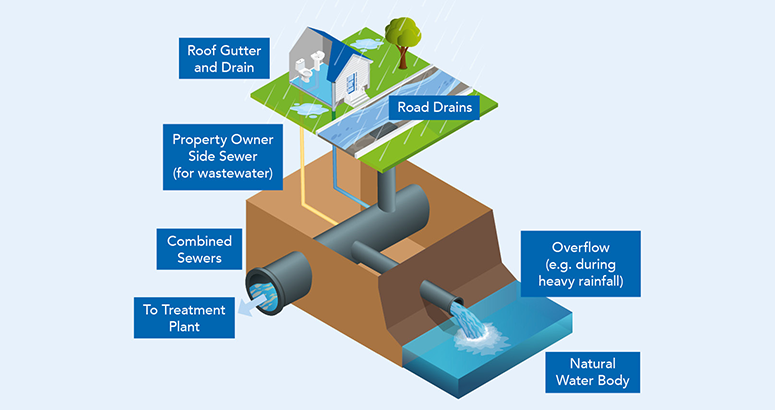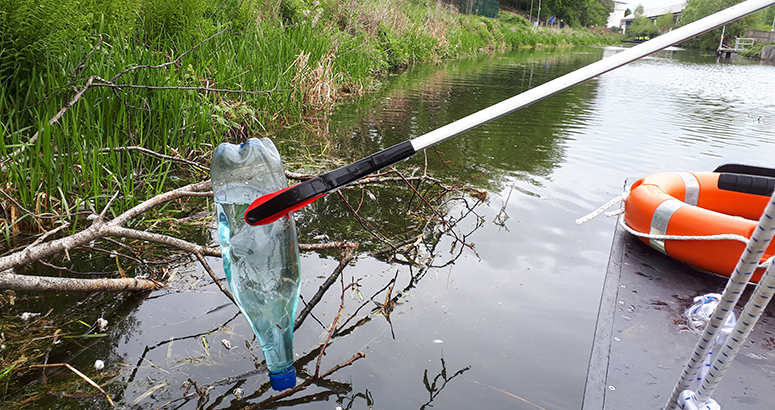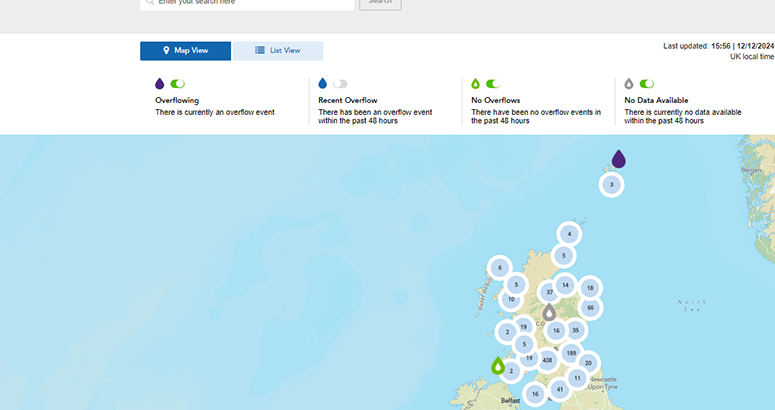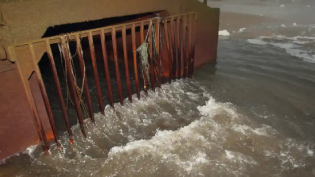Overflows Explained
What is an Overflow?
Overflows are an essential safety valve to stop excess waste water from overwhelming our sewer network and flooding people's homes, streets, and communities.
Climate change means we’re experiencing increasing extreme rainfall events, which increases the risk of our sewer networks becoming overwhelmed. So, these overflows are crucial to our wastewater network to help protect customers’ homes and the environment.
They’re designed to operate automatically as a relief system during heavy rainfall and storm events, or a sewer system failure, such as electrical, mechanical, power, and/or blockages.
During these events, the overflows operate to help drain the rain and safely release the excess waste water into waterbodies, such as rivers, lochs, and seas. Once rainfall subsides and the levels in the sewer network reduce, the overflows will stop automatically.
We’re granted licences by the Scottish Environment Protection Agency (SEPA) allowing us to operate overflows.

Our Waste Water Network
Our current drainage network operation includes combined, separate and partially separate sewerage systems. This infographic illustrates how a combined system works.
Overflows and their Impact on the Environment
When our sewer network becomes overwhelmed, we must manage excess surface and waste water back into the environment or face flooded homes and communities.
We work to manage that in a way that has the least impact on the environment. If we identify an overflow as unsatisfactory, it will be considered a priority for investment.
Not every overflow event is sewage pollution, and if they work as intended, they shouldn't cause any environmental harm.
Typically, during overflow events, around 99% of the excess water is surface water from roads and roofs, along with 'grey' water, which is waste water from household or business appliances, sinks, and showers. Only around 1% comes from our toilets. This means that any waste water released into our waterbodies is very diluted.
It’s also important to know that our overflows are permitted to release excess waste water into the environment under Water Environment (Controlled Activities) (Scotland) Regulations (CAR) licenses with conditions set by our regulator the Scottish Environment Protection Agency (SEPA).
Why We Need Overflows
We know that in an ideal world, no one wants any waste water at all released into our waterbodies.So let’s just get rid of them all, right? The honest answer is we can’t.
Scotland still has a largely Victorian sewer network, and we can’t dig it up and replace it all at once without ripping entire communities apart.
We invest £millions every year upgrading and replacing our sewer network and finding better ways to deal with excess surface water.
So, for now, we must rely on overflows to help manage the risk of sewer flooding, while working hard to find better measures in all future development.
If overflows are working as they should, in most cases they won’t have an adverse effect on the environment.
We have different types of overflows that operate in different ways. These are:
- Combined Sewer Overflow (CSO) which stops the system from becoming overwhelmed during heavy rainfall
- Settled Storm Sewage Overflows (SSSO), a form of CSO that provides a level of treatment or settlement before overflowing
- Emergency Overflow (EO), which should only operate in the event of sewer system failure and should not operate in response to rainfall
Our overflows are permitted to release excess waste water into the environment under Water Environment (Controlled Activities) (Scotland) Regulations (CAR) licenses with conditions set by our regulator the Scottish Environment Protection Agency (SEPA).
What Scottish Water is Doing
We take our environmental responsibilities very seriously and we’re working hard to improve the way our overflows operate to further minimise any environmental impact.
We’re increasing the data we collect and publish to help us make better-informed decisions on investment priorities.
We’re at a great starting point. Scotland’s waterbodies are already at a consistently high quality at around 87% - much higher than in England and Wales. But there’s always room for improvement.
We launched our Improving Urban Waters Routemap in 2021, setting out our commitments to improve water quality; increase monitoring and publication of data; reduce sewer-related debris in the environment, and reduce overflow events from the sewer network.
We’ve now met our commitment committed to installing 1000 new EDM monitors by the end of 2024 and we’re sharing this data with customers as we get it through our new near real-time Overflow Map.
In addition, we plan to install further EDMs to take the total to over 2,000 by the end of 2025.
Over the past decade, we've invested £2.7 billion to understand and reduce the impact of our network on the water environment.
We already have a lot of information about how our assets are performing and their impact on the environment from our Environmental Studies programme which started in 2015.
We're able to prioritise our investment based on these studies and insight from new near real-time data will help us decide where we need to focus investment in the short, medium, and long term.
Prioritisation of Sewer Overflows in Scotland
Information on how we prioritise overflows in Scotland
InformationWhat You Can Do
Scottish Water belongs to you. It truly does.We’re publicly owned, so every penny we make is reinvested in our infrastructure to keep water and waste water services the way you want them.
Climate change and how we use water mean we face challenges in how we manage waste water and surface water back into the environment.
But you can play an owner's part by supporting our campaigns to encourage responsible behavior around waste water.
For example, people report seeing ‘raw sewage’ in a water body. Often, what they see is sewage-related debris - wet wipes, period products, and other items wrongly flushed down the toilet - which has made its way into our sewer network.
When the overflow operates as it's designed to do in heavy rainfall, those items can then find their way into our waterbodies.
That’s why we’ve launched our Nature Calls campaign, asking everyone to bin the wipes, and we urge people to follow the 3Ps – flushing pee, poo, and toilet paper only- and no Fats, Oils and Grease (FOGs) down the sinks and drains. See our Bathroom Checklist and Kitchen Checklist for more information.
Overflow Map
We’ve launched our near real-time Overflow Map to share information with our customers at the same time as we see it.
This interactive map shows all monitored overflows for which we’re able to share data on the Scottish Water wastewater network, apart from those operated on our behalf by Private Finance Initiative (PFI) companies.
The map is automatically updated every 60 minutes and can be used to see if overflows are currently discharging into a waterbody, including details of the two most recent events, and a total within the past 48 hours.
It also provides information on the priority level for planned investment for each location.
The new data should check against what we already know and will confirm where we should prioritise investment.
For help to understand the information displayed on the map we have an Overflow Map FAQs section on the Overflow Map page.
This overflow map is in addition to the data we already publish annually.
Overflow Map
Access near real-time data from our monitored overflows and FAQs to help you understand the information
MapThe Data We Publish
We report overflow data in the regulatory return annually to SEPA in line with specific requirements set out within our licences.
We first published this information on our website in December 2022 (2017 to 2021 data). It was updated in 2023 and again in 2024 to show data for the previous five-year period. Updates will be published annually in the future.
Our commitment to making more data available is one of the commitments in our Improving Urban Waters Routemap.
As a result, verified data for additional monitored overflows was first published in December 2023 (2022 data). That’s been updated to include 2023 data and updates will be published annually going forward.
As we continue our review, verification processes, and monitor installation programme, we will look to publish data for further monitored overflows where available in the future.
Published Overflow Data
Find out more about the data we publish which is available to download
Information








